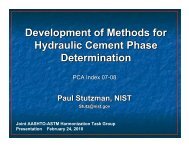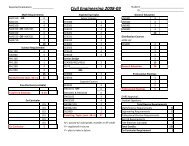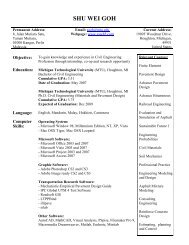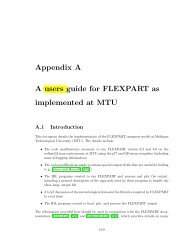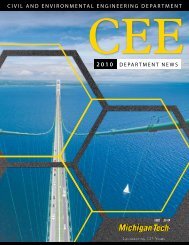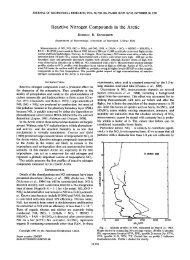Evaluation of Septic Tank and Subsurface Wetland for
Evaluation of Septic Tank and Subsurface Wetland for
Evaluation of Septic Tank and Subsurface Wetland for
Create successful ePaper yourself
Turn your PDF publications into a flip-book with our unique Google optimized e-Paper software.
Abstract<br />
Locally designed wastewater treatment systems at two rural Jamaican public schools<br />
located in Pisgah, St. Elizabeth <strong>and</strong> Retrieve, St. James, were evaluated over a seventeen<br />
week period to evaluate their effectiveness. Primary treatment was achieved with two<br />
plastic tanks in series. This was followed by a horizontal subsurface flow constructed<br />
wetl<strong>and</strong> planted with local wild cane (Gynerium sagittatum) achieving secondary<br />
treatment with nutrient removal. (In Jamaica, this is referred to as tertiary treatment.)<br />
The toilet system in Pisgah had been operating <strong>for</strong> one <strong>and</strong> a half years supplied with<br />
water from a rainwater harvesting scheme. Per capita water use averaged 1.3 L/p-d <strong>and</strong><br />
total water use averaged 264 L/d (70 USgal/d). This resulted in such low hydraulic<br />
loading that the septic tanks had a hydraulic residence time (HRT) <strong>of</strong> 29 days. The<br />
wetl<strong>and</strong> never produced effluent so that it functioned as an evapotranspiration (ET) bed<br />
with an average ET rate <strong>of</strong> 0.27 USgal/ft 2 /d (11 mm/d). Wetl<strong>and</strong> BOD mass loading<br />
averaged 0.79 kg/ha-d (0.71 lb/ac-d) <strong>and</strong> TSS entry zone mass loading averaged 0.0013<br />
lb/ft 2 -d (6.4 g/m 2 -d). The toilet system in Retrieve had been operating <strong>for</strong> two years with<br />
a municipal water supply. Per capita water use averaged 48.3 L/p-d <strong>and</strong> total water use<br />
averaged 3,240 L/d (857 USgal/d). The average septic tank HRT was 1.2 days.<br />
Combined sewage inflow <strong>and</strong> precipitation to the wetl<strong>and</strong> resulted in an average HRT <strong>of</strong><br />
2.2 days equivalent to a hydraulic load <strong>of</strong> 2.6 USgal/ft 2 -d (105 L/m 2 -d). Wetl<strong>and</strong> BOD<br />
mass loading averaged 15 kg/ha-d (13 lb/ac-d) <strong>and</strong> TSS entry zone mass loading<br />
averaged 0.0038 lb/ft 2 -d (19 g/m 2 -d).<br />
Five sets <strong>of</strong> water quality grab samples were collected from three points at each site.<br />
Samples from the sanitation system in Pisgah indicated an average reduction <strong>of</strong> raw<br />
sewage BOD by 78%, TSS by 85%, total nitrogen by 95%, ammonia by 99%, total<br />
phosphorus by 97%, total coli<strong>for</strong>m <strong>and</strong> fecal coli<strong>for</strong>m by 4 log (99.99%). Samples from<br />
the sanitation system in Retrieve indicated an average reduction <strong>of</strong> the raw sewage BOD<br />
by 50%, total nitrogen by 68%, ammonia by 97%, total phosphorus by 64%, total<br />
coli<strong>for</strong>m by more than 3 log <strong>and</strong> fecal coli<strong>for</strong>m by more than 4 log. An increase in TSS<br />
<strong>for</strong> the system at Retrieve may have been caused by the effluent sampling method.<br />
Average nitrate levels were below 1 mg/l throughout both sanitation systems.<br />
iii



